Last updated: November 2, 2021
Article
Road to Recovery? Park Staff Assess and Repair Storm Damaged Historic Carriage Roads and Trails
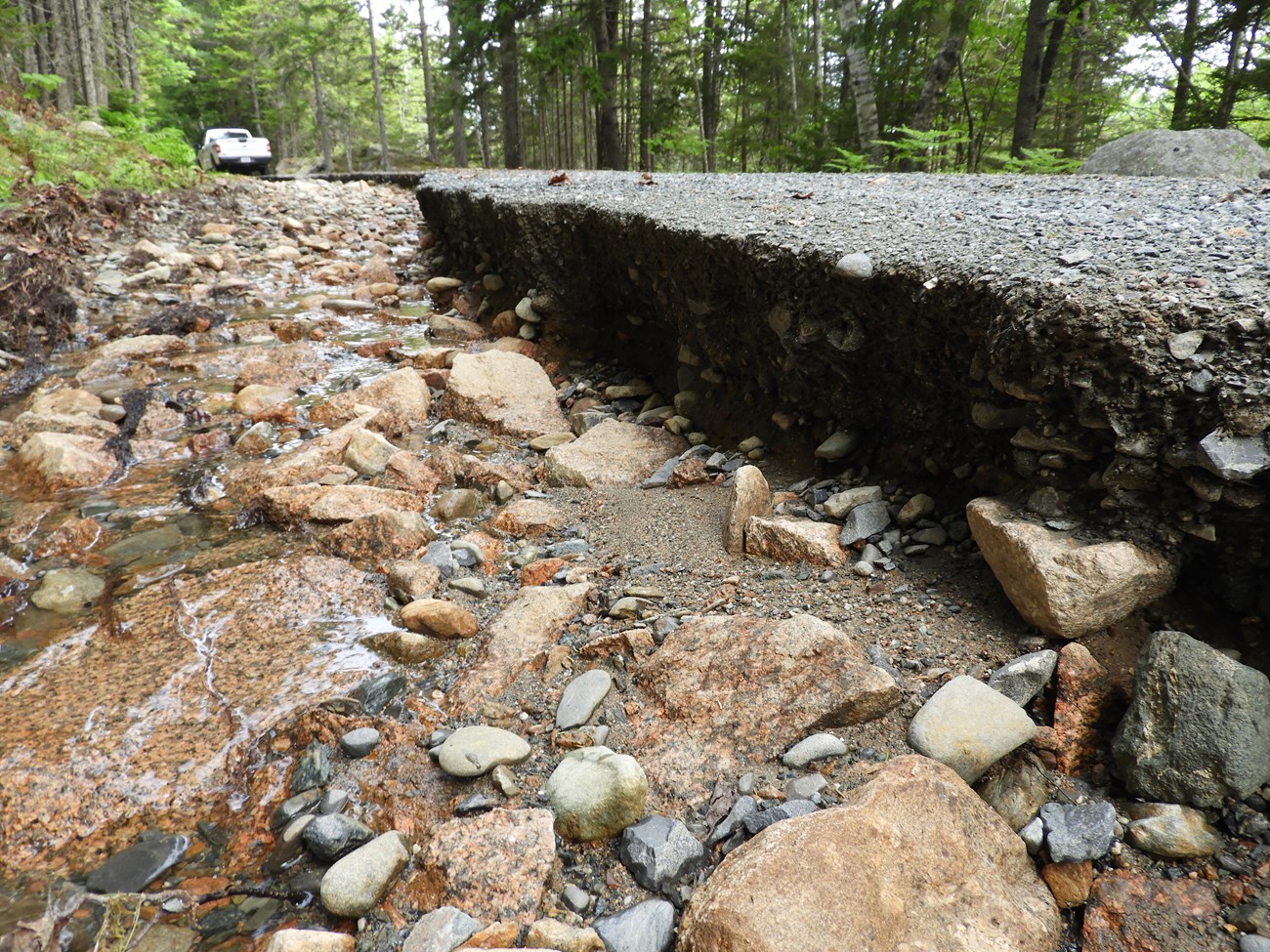
NPS Photo
The June 9, 2021 storm dropped a record-breaking 5+ inches of rainfall on portions of Acadia National Park in less than 3 hours. A park stream gage rose over 8 feet and streamflow increased from 0.61 cubic feet per second to 527 cubic feet per second. Acadia's 45-mile historic carriage road system suffered extensive damage, as did trails and paved roads. As the rushing water was shedded from the roads, upwards of 300-400 tons of carriage road surface material was swept into the woods and decades of soil eroded away from the surrounding forest. Just over one month after the storm, initial assessments identified over $1.5M in damage and repair costs.
To most visitors, Acadia's historic carriage roads are a recreational resource, providing endless hours of car-free travel in a beautiful setting. The sweeping turns, gradual climbs, arched bridges, forest-framed views, and soft crunch of stone feasts the senses as much as it raises heart rates. For park managers, the historic carriage road network lies at the nexus of park management - a heavily-used recreational resource that is also a vast infrastructure network, as well as a nationally-registered historic resource, surrounded by world-renowned natural ecosystems.
Assessing the damage and designing the road to recovery is complicated and costly even for the skilled professionals who care for the historic carriage roads their entire careers. On the days that followed the rainstorm, park staff quickly scrambled to assess and repair the damage; a process that will be ongoing for years. As climate change drives storm intensity now and into the future, can the park keep up?
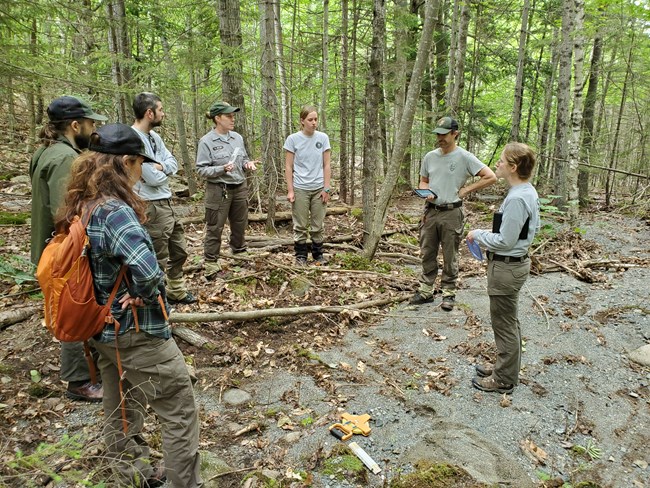
NPSPhoto
Assessing the Damage
In the immediate aftermath of the record-breaking June 9th storm, park maintenance, resources management, and emergency management staff fanned out across the 45-mile network of historic carriage roads to assess the damage. Radio calls from the field and on-the-ground assessments carried back reports of damage severe enough to warrant a 10-mile closure of carriage roads, in addition to closures of Schoodic Peninsula bicycle paths and other road and trail closures across the park. Visitor safety was paramount as bicyclists traveling up to 20 mph on the carriage roads could seriously injure themselves on washed out areas. Press releases and social media posts announced road and trail closures to the public and signs, cones, and other safety warnings were quickly deployed to protect the visitors and prevent any further damage to the historic roads themselves.
Then the long haul work began. How extensive was the damage? What exactly was damaged? Where was the damage? How would the park plan for and pay for recovery? And finally, how can the park repair the roads in a way that takes into account the increased frequency and intensity of storms caused by climate change?
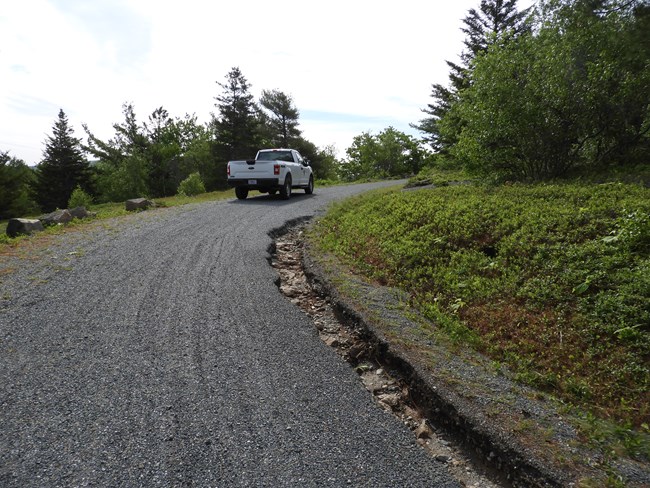
NPSPhoto
Layers of History
Though Acadia's historic carriage roads were constructed from 1913 to 1940, they were engineered to withstand heavy rainfall. Expertly-designed stone culverts and various drainage systems provide sufficient paths for water to flow away from the road surface and into appropriate channels. The carriage roads have a substantial crown to ensure good drainage. The roadbeds themselves consist of multiple layers of rock graduating from large to fine-sized stones at the surface in a historic and proprietary mix. Factored together, a lot of 19th and 20th century engineering and planning went into preventing large scale damage from storm runoff.
Since their original construction, park staff maintain the historic carriage roads to the highest standards. Starting in the 1990s, the Friends of Acadia have vigorously supported extensive maintenance of the carriage roads to preserve their condition into the future. The historic culverts and drainage system designed by John D. Rockefeller Jr. and built by skilled craftsmen were no match for the 'monsoon' nature of this rain event. What does it mean to preserve the carriage roads in the face of the increased frequency and intensity of these storms driven by climate change?
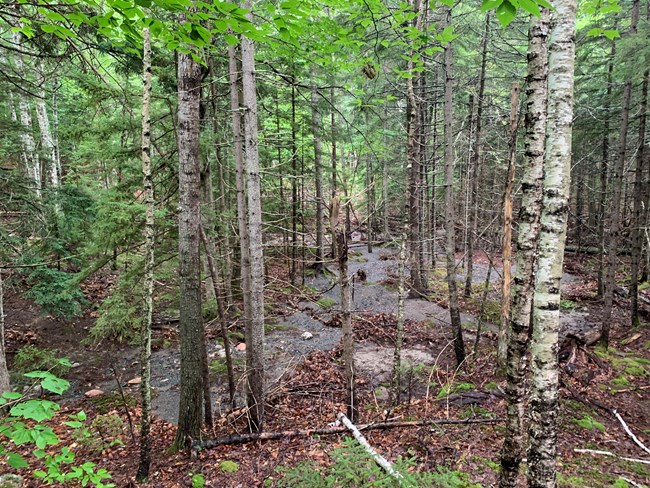
NPSPhoto
Not Just Road Damage
Upon assessment, extensive damage was discovered not only to the historic carriage roads, but also to natural environment surrounding the carriage roads. As hundreds of tons of carriage road surface materials was washed into the woods, unprecedented natural resource damage faced the park. The dense tree cover of most of Acadia's woods acts as a natural umbrella for the forest floor, softly shedding water and protecting precious soils. On June 9th, the tremendous rush of water stripped important soil from tree roots and washed away vegetation. This leaves trees more susceptible to disease and drought conditions.
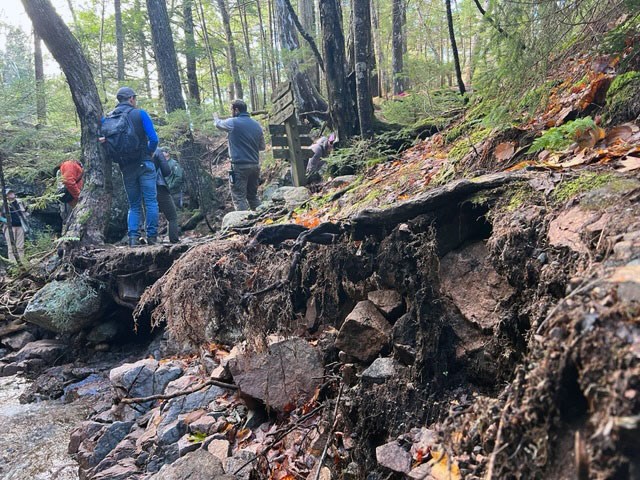
NPSPhoto
Closing Historic Maple Springs Trail
Historic documentation dates the Maple Springs Trail from possibly the late 1800s. Passing through a beautiful gorge, the trail provides access to Hemlock Bridge, the Giant Slide Trail, and then the Sargent Mountain South Ridge Trail. The June 9 storm has washed out various sections of trails that were once lined with masterful stonework craftsmanship (including steps and walls). In November of 2021, the trail was the last remaining section of carriage roads and trails to remain closed due to the storm damage. During the closure, park staff, volutneers, and partners from the Friends of Acadia visited the trail to assess the damage and strategize on management strategies for the future. Climate change, which is causing heavier and more frequent rain events, is in the forefront of park managers and scientists minds as varous options are considered.
Management strategies could include:
- abandoning the original trail course and relocating the trail out of the gorge completely to prevent costly replacement of trail features that may just be washed out in future climate-driven storms;
- replacing the trail in kind (as it was) and keeping up with future storm damage, thus preserving the orignal trail experience of hiking through the beautiful gorge; or
- abandoning the trail all together and directing visitors to nearby trails that would connect visitors to the same trails that Maple Springs trail did but without hiking through the gorge.
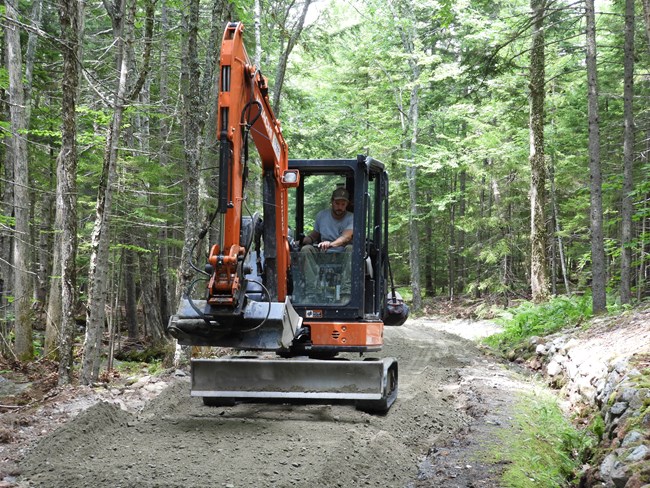
NPSPhoto
Recovering for Recreational Use
The initial focus of recovery efforts was to repair the historic carriage roads for recreational use. Particularly in 2021, with record visitation numbers come out of the pandemic, demand for use was high among hikers, bikers, and horse riders. The Eagle Lake carriage road loop was also closed at the time of the June 9 storm due to a preplanned construction project. With the addition of the 10-mile carriage road closure due to the storm, almost half of the carriage road system was offline at the start of a busy visitor season. As the carriage road network is one of the primary resources of Acadia National Park, park staff worked quickly to repair as many miles of roads as possible.
Crews quickly deployed across the carriage road system to replace materials to the roads, using whatever stockpile of materials were on hand. Quickly depleting existing stockpiles, the park sought emergency relief funding and contracted out for more materials and assistance in the repair.

NPSPhoto
What Does the Future Hold?
Though the recreational resource has largely been reopened to the public, uncertainty remains around the best approaches for protecting Acadia's historic carriage road network and surrounding environment into the future. The park is adapting cloud-based GIS technology typically used for wildland fire to document the damage. Park staff are reaching out to various partners in science and engineering to examine the best practices for repair and preservation. Though the drainage systems built with the carriage roads in the early 1900s are sufficient for safely shedding typical rain events, a warming climate is increasing the frequency and intensity of rain events such as the June 9 storm.
To adaptively manage these important resources, the team of park scientists, facility specialists, and managers are looking closely at whether up-sizing drainage systems is needed to prevent further damage. Though it may be unsightly park staff are looking at placing temporary fencing to prevent further damage until full restoration can be complete. Long term monitoring plots may be set up in the forest to look at the impact of the loss of soil on the surrounding forest.
The team at Acadia National Park will continue to work at the nexus of science, engineering, recreation, nature, and history to find the road to recovery for Acadia's historic carriage roads.
